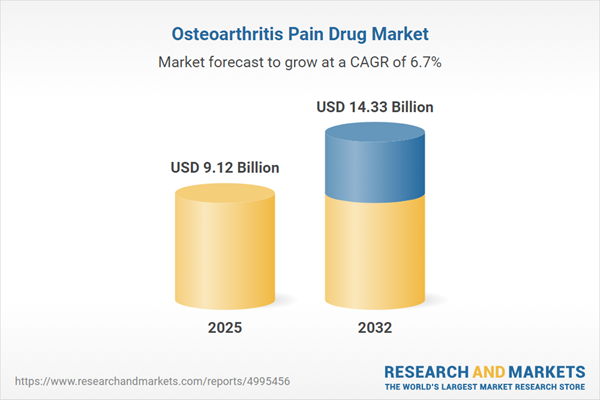Speak directly to the analyst to clarify any post sales queries you may have.
The osteoarthritis pain drug market is rapidly transforming, shaped by regulatory developments, clinical innovation, and the industry’s increasing focus on delivering tangible, patient-centered care outcomes. Senior decision-makers navigating this space must continuously refine their strategic and operational approaches to keep pace with dynamic healthcare demands.
Market Snapshot: Osteoarthritis Pain Drug Market Size and Outlook
In 2024, the osteoarthritis pain drug market is valued at USD 8.54 billion, with growth projected to USD 14.33 billion by 2032, reflecting a CAGR of 6.67%. Expansion is fueled by demographics such as an aging population and ongoing advances in the pharmaceutical industry. Digital therapeutics are playing a transformational role in how payers and providers measure patient outcomes and ensure treatment consistency. Companies equipped to meet shifting expectations and navigate a more regulated, competitive environment are well positioned to secure sustainable advantages.
Scope & Segmentation: Comprehensive Opportunities in the Osteoarthritis Pain Drug Industry
- Product Types: The portfolio includes corticosteroids, NSAIDs, cyclooxygenase-2 inhibitors, symptomatic slow-acting drugs, and viscosupplements. These offer flexibility in clinical decision-making, from quick symptom relief to long-term management.
- Routes of Administration: Injectables, oral tablets, and topicals (such as gels, creams, and patches) cater to varied care protocols, supporting both clinical and self-managed patient needs.
- Distribution Channels: Hospitals, retail pharmacies, and online platforms broaden market access and support improved therapy adherence by aligning with patient preferences and care patterns.
- End Users: Solutions address diverse provider settings like clinics, integrated hospital networks, and home healthcare organizations, demonstrating versatility across multiple points of care.
- Patient Age Groups: Products are tailored to adolescents, adults, and elderly groups, allowing for customized dosing and targeted monitoring across the spectrum of osteoarthritis care.
- Disease Severity: Therapeutic approaches cover early-stage to severe osteoarthritis, enabling personalized regimens and a combination of standard and novel protocols.
- Geographical Regions: Focus spans the Americas, Europe, Middle East & Africa, and Asia-Pacific. Each area is influenced by its own policy environment, healthcare infrastructure, and funding models—requiring locally responsive commercial strategies.
- Competitive Landscape: Leading players include Pfizer Inc., Novartis AG, Bayer AG, Johnson & Johnson, Sanofi S.A., GlaxoSmithKline plc, Viatris Inc., Teva Pharmaceutical Industries Ltd., Sandoz International GmbH, and Perrigo Company plc. Their continued investments in R&D and new product launches shape industry trajectory.
Key Takeaways for Senior Decision-Makers
- Integrating digital monitoring and innovative drug formulations enhances patient segmentation and enables companies to offer precisely tailored therapies.
- Proactive regulatory planning and sophisticated health economics models increase the likelihood of successful entry and expansion into both well-established and emerging regions.
- Investment in advanced injectables and biologic drugs increases organizational readiness for evolving treatment standards and emerging clinical needs.
- Adapting to varying reimbursement mechanisms across regions supports more agile market penetration and ensures faster deployment of new therapies.
- Utilizing robust data analytics directs resources to high-value patient segments and improves care delivery efficiency across treatment pathways.
- Scaling digital platforms strengthens patient engagement and supports evidence-based clinical outcomes for healthcare stakeholders across multiple environments.
Tariff Impact: Supply Chain Strategy in Response to Regulatory Change
Recent U.S. tariff changes have compelled osteoarthritis pain drug manufacturers to rethink supply chain models. Efforts such as diversifying suppliers, increasing near-shoring, and deploying real-time analytics mitigate operational uncertainties and sustain uninterrupted delivery and research activities. These measures support stable business operations and ongoing product development amid regulatory shifts.
Methodology & Data Sources
This analysis is based on expert interviews, panel discussions, and critical review of published clinical studies and healthcare policy research. Proprietary data modeling and scenario-based analysis underpin validated, objective recommendations tailored to rapidly evolving market forces.
Why This Report Matters
- Provides practical frameworks to forecast trends and identify core and emerging opportunities within the osteoarthritis pain drug sector.
- Improves segmentation strategies and competitor benchmarking for healthcare payers, providers, and diverse patient groups worldwide.
- Equips decision-makers with proven risk management tools and comprehensive supply chain strategies to manage regulatory and operational uncertainty.
Conclusion
Armed with comprehensive analysis and actionable guidance, leaders gain the insight needed to adapt in the changing osteoarthritis pain drug market and achieve robust, sustainable progress.
Additional Product Information:
- Purchase of this report includes 1 year online access with quarterly updates.
- This report can be updated on request. Please contact our Customer Experience team using the Ask a Question widget on our website.
Table of Contents
3. Executive Summary
4. Market Overview
7. Cumulative Impact of Artificial Intelligence 2025
Companies Mentioned
The companies profiled in this Osteoarthritis Pain Drug market report include:- Pfizer Inc.
- Novartis AG
- Bayer AG
- Johnson & Johnson
- Sanofi S.A.
- GlaxoSmithKline plc
- Viatris Inc.
- Teva Pharmaceutical Industries Ltd.
- Sandoz International GmbH
- Perrigo Company plc
Table Information
| Report Attribute | Details |
|---|---|
| No. of Pages | 188 |
| Published | October 2025 |
| Forecast Period | 2025 - 2032 |
| Estimated Market Value ( USD | $ 9.12 Billion |
| Forecasted Market Value ( USD | $ 14.33 Billion |
| Compound Annual Growth Rate | 6.6% |
| Regions Covered | Global |
| No. of Companies Mentioned | 11 |









